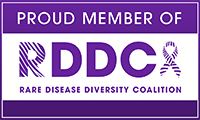![]()
Glossary of Scleroderma-Related Terms
The glossary of terms provides definitions for terminology associated to scleroderma.
Acid reflux
Stomach acid, which abnormally travels up into and irritates the esophagus.
Alveoli
Tiny air sacs in the lungs, essential for gaseous exchange. The alveoli allow oxygen to get into your blood and remove carbon dioxide.
Auto-antibodies
Antibodies that target your body’s own cells, instead of invaders.
Autoimmune
Disease where the immune system acts against the person’s own body. ‘Auto’ = self; ‘Immune’ = protection against.
Calcinosis
Hard lumps (made from calcium) that develop on pressure points or around joints.
Collagen
A type of connective tissue fiber that holds the body’s cells in place.
Connective tissue
The substance that makes up the body’s shape, connecting and separating different parts.
CREST
Form of scleroderma, whose initials stand for Calcinosis, Raynaud Phenomenon, Esophageal dysmotility, Sclerodactyly and Telangiectasia.
Cutaneous
Of the skin
Diffuse Scleroderma
A subtype of scleroderma where excess collagen production causes skin thickening over large areas of the body, usually the fingers, hands, arms, anterior trunk, legs and face.
Dysfunction
Impaired or abnormal functioning.
Dysphagia
Difficulty in swallowing.
Edema
An abnormal excess accumulation of fluid in tissues or cavities of the body.
Fibroblasts
The most common type of cell found in connective tissue. They secrete collagen proteins that are used to maintain a structural framework for many tissues.
Fibrosis
The development of fibrous connective tissue as a reparative response to injury or damage. When fibrosis occurs in response to injury, the term “scarring” is used.
Flexion contracture
Fingers become fixed in a bent or flexed position.
Heartburn
Pain in the center of the chest caused by acid reflux.
Heterogeneous
Varied or mixed.
Hypertension
Abnormally high blood pressure
Immune system
Your body’s defense system against invading bacteria, viruses, and other causes of disease.
Inflammation
A normal response from your immune system, causing the affected part of the body to become red, swollen, hot, and often painful, in reaction to injury or infection.
Interstitial Lung Disease (ILD)
When inflammation and scarring to the lung tissue makes them stiffer and thicker and makes it difficult to breathe.
Joint contracture
Fixation of a joint in one position preventing full range of motion
Morphea
Another word for localized scleroderma.
Pericarditis
Tissue inflammation of the sac enclosing the heart.
Peripheral blood circulation
The flow of blood to the arms and legs.
Phenomenon
An unusual, significant, or unaccountable fact or occurrence which, when observed, is of scientific interest.
Pleurisy
Tissue inflammation of the sac enclosing the lungs.
Prognosis
Prediction of the progression and end result of a disease or estimate of chance of recovery.
Pulmonary
Related to the lungs.
Pulmonary Arterial Hypertension (PAH)
A lung complication where the pressure in the blood vessels in the lungs is abnormally high.
Pulmonary fibrosis
A type of interstitial lung disease where fibrosis in the lungs makes them stiff.
Raynaud’s phenomenon
Medical condition in which problems in the small blood vessels cause fingers and/or toes to get numb, cold, and painful, with changes to skin color (usually white to blue/purple then to red).
Renal
Relating to the kidneys.
Respiratory
Relating to the act of breathing.
Rheumatoid arthritis
A long-term autoimmune condition that causes pain, swelling and stiffness in the joints.
Sclerodactyly
Thickening and tightening of the skin on the fingers or toes.
Scleroderma
The sclerosis (hardening) of the skin (derma), specifically. However, scleroderma is the term that is often used to refer to all types of sclerosis; both the skin changes and the changes in other tissue and organs in the body (systemic sclerosis).
Sclerosis
An abnormal hardening of tissues in the body.
Sine scleroderma
Means that there is systemic sclerosis involving other organs in the body, but no thickening of the skin.
Skin ulceration
A break in the skin with loss of surface tissue. It may also be associated with inflammation, calcium deposits and infection.
Symptoms
Any feeling of illness or physical or mental change that is caused by a particular disease.
Syndrome
A set of medical signs and symptoms that are linked with each other and, often, with a particular disease or disorder.
Systemic
When a disease affects several different tissues and organs in the body.
Systemic sclerosis overlap syndrome
Systemic sclerosis plus another autoimmune disease like rheumatoid arthritis.
Telangiectasia
Small red spots caused by widened blood vessels usually on the hands and face.
Vascular
Pertaining to or composed of blood vessels.

